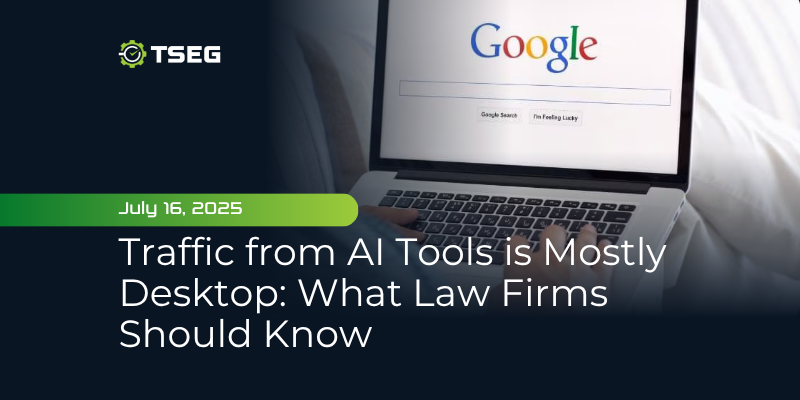Traffic from AI Tools is Mostly Desktop: What Law Firms Should Know
Posted on Wednesday, July 16th, 2025 at 6:04 pm
AI Search Drives Traffic but Nearly All of It Comes from Desktop
AI tools like ChatGPT, Perplexity, Microsoft’s Copilot, and Google’s Gemini are sending over 90% of traffic from desktop users.
Mobile has dominated internet usage for years, but AI search is flipping pattern. Desktop is where users are conducting deeper research, where AI tools are more fully featured, and where the traffic is actually converting into site visits.
If your firm is putting most of its search strategy into mobile-first content or only tracking mobile performance, you’re probably missing out on the most active AI-driven traffic source available today.
Breakdown of Where AI Traffic Is Coming From
Here’s how the top platforms compare:
- – ChatGPT sends 94% of its outbound traffic from desktop.
- – Perplexity is even more desktop-heavy at 96.5%.
- – Microsoft Bing, with Copilot integrated, delivers 95% from desktop.
- – Google Gemini sits at 91% desktop.
- – The only exception is traditional Google Search, where mobile still leads with 53%.

These figures highlight a pattern that most law firms need to track more closely. While mobile dominates general web browsing, the AI search layer is pointing users to external websites primarily through desktop environments.
There’s also a practical reason behind this. Users looking for legal information tend to spend more time on research-heavy queries. That behavior fits better with how AI tools operate on desktop. Larger screens, multiple tabs, and longer attention spans create the right conditions for AI-assisted legal searches to lead to website visits.
Why Mobile AI Usage Is Dragging Behind Desktop
AI tools are also on mobile, but that activity isn’t translating into traffic. The main reason is how these platforms handle user interaction. On desktop, clicking a citation often takes the user straight to the source. On mobile, that same action opens a preview within the app. Getting to the actual website requires an extra click, and many users don’t click a second time.
This matters for law firms because it reduces the chance that a potential client ever reaches your site. The more steps between the question and your content, the lower the conversion rate.
There’s also a clear difference in how people use mobile versus desktop during the legal search process. Mobile tends to be used for quick answers and casual browsing. Desktop is where people dig in, compare resources, and take notes. If someone is looking up what to do after a car accident, they might start on their phone. But if they’re deciding who to hire or what steps to take next, they’re more likely to sit down at a computer.
That intent gap explains why AI referrals are coming from desktop. The tools are built to serve longer, research-driven queries, and they reward pages that offer deeper information. Until mobile versions of these platforms send users directly to source websites more consistently, desktop will remain the more reliable traffic source.
Build for the Traffic You Can Get Today
With desktop AI tools responsible for nearly all referral traffic, law firms should prioritize what is already delivering results.
Focus on content formats that AI tools are more likely to reference. That means longform pages with strong internal structure, descriptive headers, and well-organized answers. These elements make it easier for AI systems to surface your content during legal research.
Think about what someone researching a legal problem wants to know. They aren’t just searching for “injury lawyer near me.” They want to understand what steps to take after an accident, what their rights are in a specific state, or whether their situation justifies a claim. Your site needs to answer those questions clearly and in full.
Adding schema markup helps AI tools identify what each section of your site covers. This increases the chances of getting pulled into an AI response. Mark up your FAQs, services, reviews, and attorney bios with the right tags.
Many firms still treat mobile formatting as the main concern. But for traffic coming from AI, the real opportunity is in desktop formatting. Until the referral pattern changes, desktop should lead your content planning.

Get Ready for Mobile Without Losing Ground on Desktop
Desktop continues to drive most AI referrals, but that won’t last forever. Mobile AI tools are still in early stages. Apple has yet to bring AI into Safari. Google is running tests on mobile overviews. The referral gap is a result of current platform limitations, not user demand.
Law firms should improve mobile readiness now while continuing to build on what desktop already delivers. That includes fast load times, clean mobile layouts, and well-organized content that AI tools can easily read.
At the same time, desktop-focused pages are doing the work today. Research guides, state-specific legal breakdowns, and detailed FAQ sections are getting cited by AI platforms and driving traffic.
Maintaining both formats requires more than just adjusting templates. It takes a deliberate approach to content planning, page structure, and user intent. TSEG helps law firms build digital systems that match how people search and how AI delivers results. As these tools continue to change, we make sure your firm doesn’t fall behind. Contact TSEG today to learn more.
